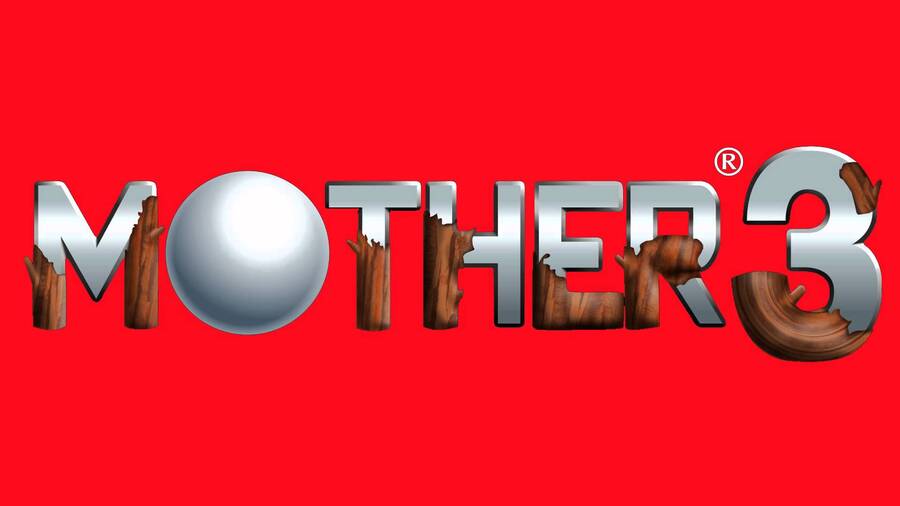
This week marks the 10th Anniversary of Mother 3, Shigesato Itoi's third and final instalment in the Mother series and the follow up to EarthBound that, unfortunately, never saw the light of day outside of its native homeland. Since that day ten years ago we've seen hopes dashed, rumours (some of them recent) circulate, fan projects born and distant glimmers of hope materialise. Never in the history of the medium - arguably - has a Japan-only title received such a demand for a Western release. After a turbulent ten years, will Mother 3 ever see that fabled official release?
The title's foundations began in 1994 as a follow up to Mother 2 (EarthBound). By late 2000, Mother 3's journey had spanned three consoles, beginning development on the Super Famicom before transitioning to the Nintendo 64 and eventually the Nintendo 64 DD add-on. Mother 3's difficulties eventually culminated in a devastating KO to the RPG, and after a little over a quarter of the title's completion it was scrapped altogether. In a rather telling developer interview that touched on the countless issues the team underwent, Itoi stated - "Of course I have a lot guilt. I had players ask me every single day when the game was coming out. I'm sorry. I've failed you." Itoi didn't let that failure or culpability deter him from keeping the dream alive, and spurred on by the eagerness and passion of the fans Mother 3 was revived once more. With the help of Brownie Brown (now 1-Up Studio), development of Mother 3 shifted over to the Game Boy Advance. Gone were the polygons and Wild West setting of the original rendition, and in its place was a title much more reminiscent of its predecessor.

With the title eventually releasing in Japan on the GBA on April 20th 2006, over a year after the release of the Nintendo DS in North America, Nintendo understandably opted out of releasing such a niche title overseas on a handheld system losing ground to its successor. With the underwhelming reception EarthBound's American release received - in terms of sales - as context, Nintendo was undoubtedly deterred from giving the game a global release, and Mother 3 was seen as a glove that solely fit the hand of the Japanese market. The Mother fan community was not to be defeated, however, and in November 2006 - led by Clyde "Tomato" Mandelin - Starmen.net announced plans for its own fan translation. After almost two years of hard work a translation patch was released in October 2008 and was immensely popular within the first week - with the patch being downloaded 100,000 times in the first week alone.
While the fan translation was a masterful piece of work, with every line of dialogue painstakingly translated as faithfully as possible, its reach was still limited - and it never quelled the hopes of an eventual official release onto Nintendo hardware. In the years following the Japanese release there was never any indication that such a release would ever happen. While it will always be speculation, there are a number of potential reasons behind the lack of a Western release, even as a downloadable title for the Virtual Console (it's already on the Wii U VC in Japan).
Despite its child-friendly aesthetics, Mother 3 deals with a number of incredibly mature themes: Death, Sexuality, Drug Use, Animal Cruelty, Capitalism, Militaristic Dictatorships, the threat of an advancing technological age, Industrialisation, Playing God, not to mention an overlying sense of impending doom. Heavy stuff! Not exactly what one would expect from your traditional "kid-friendly" Nintendo title. While these are all tackled tastefully - preventing Mother 3 from ever becoming bleak or difficult to digest - the idea of localising so many risqué themes was sure to have dissuaded Nintendo from releasing the title outside of Japan, especially given Nintendo of America's history with localising Japanese material and a use of censorship for anything deemed "inappropriate".
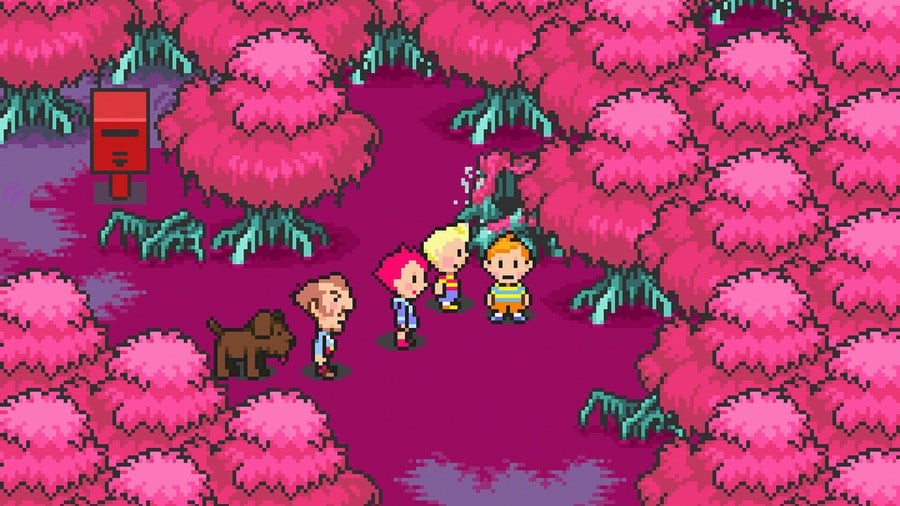
There have also been a number of comparisons drawn between in-game music and copyrighted material. Itoi is well known for letting his passions bleed into his work, and this is usually most noticeable through the soundtrack, with the Beatles particularly being a source of inspiration for Itoi and his choice of musical accompaniment. Where some see tunes as innocent tributes influenced by Itoi's musical heroes, more legal minded individuals may see cause for court action - a fiasco Nintendo would like to avoid altogether.
Perhaps most importantly, up until the past few years, demand for Mother 3's release simply wasn't big enough. There has always been a cult following of the franchise since the release of EarthBound in North America back in 1994, but did Nintendo see any profit whatsoever in releasing Mother 3 in the West? Probably not. For the first time in its history, though, that is certainly shifting. With the frequent inclusion of Lucas in the Smash Bros. series, Virtual Console releases of EarthBound and the recent arrival of EarthBound Beginnings (Mother 1), the series is now more relevant than it has ever been in the West. Rarely would a figurine of a protagonist from an unreleased title be released onto the market, but we have seen Lucas characterised in amiibo form. Undoubtedly an unusual decision, unless Nintendo has something up its sleeve.
Those who are unfamiliar with Mother 3 may be wondering - "What's all the fuss about? Why is a ten year old Japanese GBA title quite so in demand?". Mother 3 serves as one of the most deep, mature, thought-provoking and shocking narratives Nintendo has ever released, all glossed over with the usual charm and brightly coloured visuals one would expect from its titles. Throw in a bit of typically Japanese slapstick comedy and a fun battle system, Mother 3 single handedly deflates the popular (and baseless) argument that Nintendo only produces child-friendly products. Able to make you laugh and cry in equal measure, the third instalment in the series balances humour and sorrow like they go hand-in-hand. Lucas and his twin brother Claus personify the complex themes of the title perfectly. Youthfulness and maturity, hope and despair, life and death - all set against a fantastical backdrop that resembles an amalgamation of Japanese and American culture, with Dragons, Pigmasked Men and Flying Whatchamacallit's thrown in for good measure.
Though Mother 3's battle system is probably its weakest point, it did things that are still fairly unique and downright enjoyable to this day. Most notable are audio-based attacks, effectively a musical rhythm-game built into the battle system. When landing a hit, timing button mashes into the beat of the theme music allows for a chain of (often devastating) combo attacks. This feature may have become rather trite had it been set to the same battle-theme time and time again, but the multiple tunes used for the large and varied amount of enemies keep the battles fresh, enjoyable and requiring a greater sense of attention. This battle system almost serves as a game-within-a-game, making encounters with enemies and grinding much more appealing than in Mother 3's predecessors.
Mother 3 also features the most lovable, diverse and expressive cast of characters that the series had seen. Compared to EarthBound's cast of relatively unostentatious children, Mother 3's playable roster features a young boy battling adversity, a lovable Thief with a crippled leg but a good heart, a Cowboy gripped by grief and loss, an abused and love-sick Monkey, a brash tomboy Princess, and a loyal family Dog. The non-playable characters have much bigger personalities too, not simply serving as your usual JRPG blank-faced extras offering useless advice and confusingly vague statements, but each with a background and a story to tell that ties into the overall narrative.
Should fans of the series get their hopes up? It's not advisable, given the past decade. The "Western release" (or lack of) has become a trope among fans, and a subject of humour (even among Nintendo itself if one recalls past E3 presentations). Constant rumours and hopes of a Western release have been met with coy responses from Nintendo, which happily acknowledges the demand but gives little in the way of reassurances. Never in the title's history, however, has Mother 3 celebrated a significant landmark such as a 10th Anniversary, with the series never being as relevant in the West; it's already landed on the Virtual Console in Japan in late 2015, too. If a game is to receive a worldwide re-release, what better time?

When one considers the Virtual Console release of last year's "Earthbound Zero / Beginnings" (Mother 1) in the West, a title that (while always welcome) has never received the demand Mother 3 has - Mother 3 seems like even more of an inevitability. It is now the only entry in Itoi's trilogy to remain a Japanese-only release, and it's arguably the strongest title of the series. Respected tipsters have also dropped numerous hints about a localisation and a release to coincide with the 10th Anniversary. It all sounds too good to be true, but we've all come a very long way - surely anything is possible.
Should Mother 3 be ever officially released in English, it will be interesting to see if the RPG remains in its original form, or if the dialogue, themes and music will be heavily adjusted. One thing's almost certain - Nintendo is unlikely to use the already perfected fan translation, and would be sure to let its own localisation teams deal with the matter. Anyone following Nintendo's recent Western releases will know this is an area of great debate and controversy, but if Mother 3 is to succeed outside of Japan and be fully appreciated for what is is, it will need to remain as faithful to the original Japanese release as possible; it is the themes, dialogue and storyline that make Mother 3 so wonderfully individual.
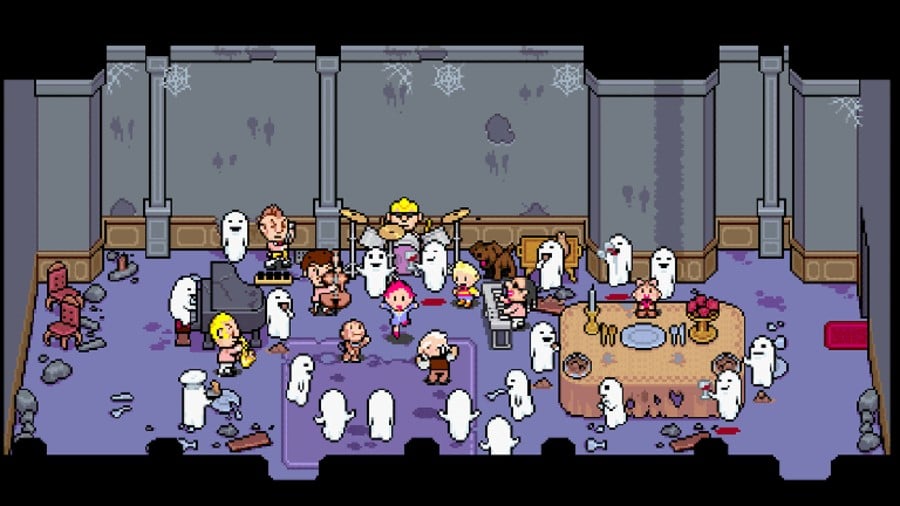
The experience one receives from playing Mother 3 is far too rich for the title to be confined to the "What If..." section of Nintendo's history. It serves as one of the most unique, wholesome and enjoyable RPG's anyone is likely to play. Mother 3 isn't just a typical JRPG – it is a lovingly crafted tale that explores a number of difficult and often untouched themes in the video game medium.
Sure, we have the ability to seek out the game in English already, and many dedicated gamers have done so. Mother 3 had a profound affect on me when I first played it, and still does to this day. Unfortunately, the reach of a game requiring emulation and fan translation patches is limited, meaning that only a tiny section of an otherwise huge fanbase get to enjoy it. With fans eager to hand over money for an official translation, we can only hope one eventually sees the light of day. After all, it was the fan's desires that kept Mother 3 alive – just maybe those hopes can see it released once more.
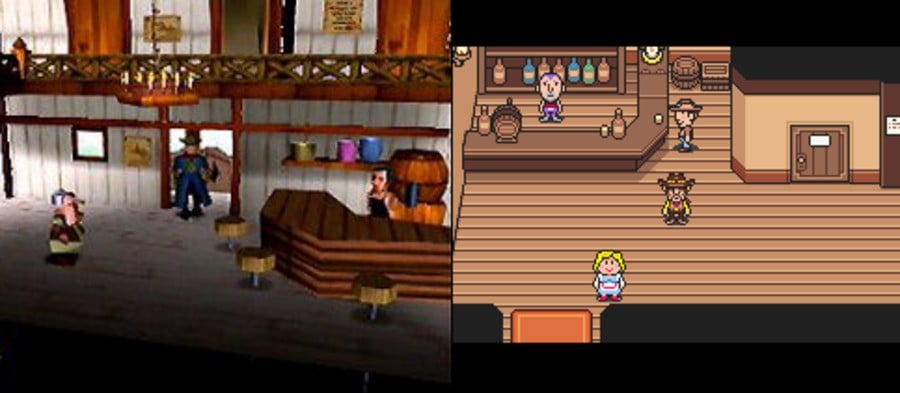
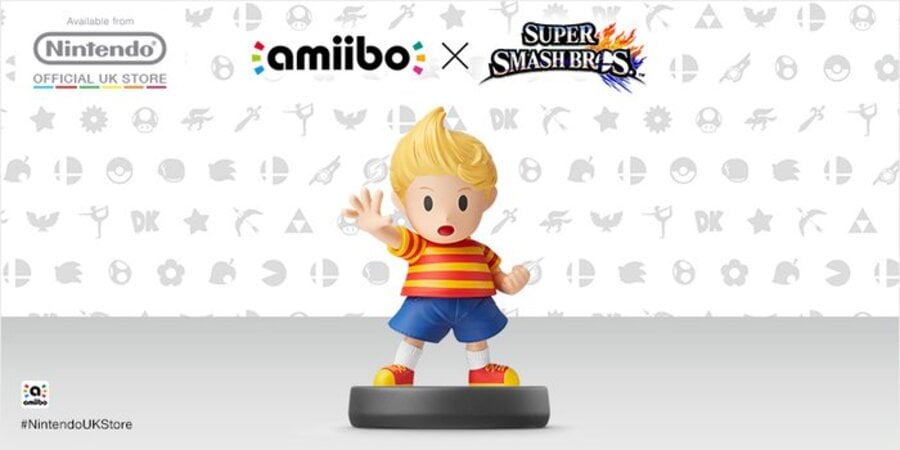
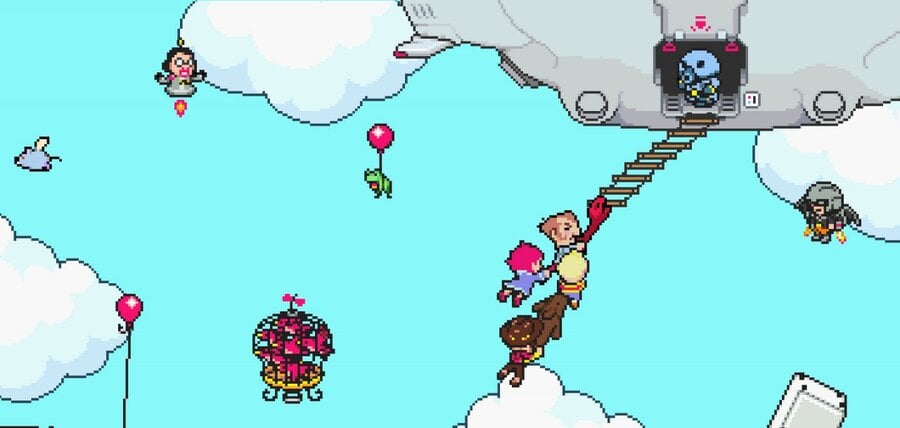
Comments 45
I saw the Mother 3 logo and almost got a heart attack! Don't do that NL!
TL;DR version: We wanted a Mother 3 localization announcement this week to celebrate the 10th anniversary. We're disappointed that we didn't.
approved by ogo79
A really cool feature on an often overlooked title. The footage of the N64 version still makes me wonder what could have been.
One of the most heartfelt and touching stories I've ever experienced in videogames. I pretty much only really didn't like the rhythm-based combat system, apart from that the game was fantastic. Can't wait for when it gets its belated release, it deserves far more than to be restricted to only the most passionate of Mother fans. 3DS/Wii U/NX whatever just get to it Nintendo!
I'm going to cry when this game finally comes to the U.S. It's probably one of my favorites of all time
I wonder if they still have the n64 prototype, for someone to stumble upon it a finish it like star fox 2 (my wish anyway. ...)
@DarthNocturnal Ooooh! I second that! People need to finally see what Roy's all about! As they say, "Roy's our boy" lol
There are people who don't believe that videogames are an art form...Mother 3 alone proves all those people wrong. It's been 10 years...hopefully this one will be the year we get it...
EarthBound has been my all time favorite game for 20 years, Mother 3/EarthBound 64 I have followed for years much to disappointment that EB64 got cancelled, then delight that Mother 3 got released, then disappointment of no Western release, then joy of a fan translation... geez as an EB fan of 2 decades you have no idea the emotional turnoil Nintendo has put us Mother fans through. It's been hell. At this point I don't get my hopes up. I don't expect a Western release any time soon but yes I would really, really, really love one. (Though the thing that would please me most more than anything in gaming, would be to finally release a completed EarthBound 64 - same game yes but different engine - although the chances of that happening are literally zero)
The one thing I've been wondering about is how they might approach Lucas getting his PK (PSI, I guess, the English Localization doesn't stick as much as "PK" to me) powers in the hot spring. Oh, boy.
I too hope we get our hands on this masterpiece.
One of the best, most powerful, most thought provoking, and most essential gaming experiences I've ever had.
If you have not played Mother 3, I hope you get a chance to one day (In English).
If you "get it", you will realise that Mother 3 is one of the greatest and most important games ever created—and it's just a load of fun to boot.
PS. I'm still actually really looking forward to this too:
http://www.mother4game.com/
It's gonna happen. It's happening. It's just w case of when now...
@abbyhitter That's [modern day] Nintendo for you.
But SURELY an English version of this game has got to come at some point soon-ish.
Perhaps they will do it at E3 this year like they did for Earthbound Beginnings last year. One can only hope.
@TossedLlama I also think I read somewhere that the timing isn't quite right in the unofficial English version that most of us have played running on emulators. And that supposedly plays an important part in the timing of the music in the battles not feeling quite right. I already absolutely love the game as is, and if the timing is actually better in an official version, it can only get even better in my eyes.
@NintendoFan64 I actually fully agree with this. I do, however, expect a lot of people will play the game and totally miss just why it really is a work of art (beyond obvious things like the visuals, music, gameplay, and understanding only the very surface level of the story). Those people will likely never fully appreciate the game they just played.
Nice column, you can feel the passion in the writing for this game. I've only played Earthbound, and it was a very fun experience, so I'd love to try this one as well. Maybe this will be a day 1, NX-VC release? Let's hope so.
Nice article and happy anniversary to Mother 3. Just makes me want the game even more.
Nice article you wrote, NL. Mother 3 is my favorite game of all time, and I really hope that this year is the year the west finally gets the game.
It's gonna happen, I know it...just wished we knew when. T.T
"Come on, Reggie, give us Mother 3!"
"How about I give you this?!?" fireball
"But what about Star Fox?"
Laser eyes
Although we did get Star Fox this year. Maybe they'll pull another Earthbound Beginnings.
Surely with the success that Earthbound and Beginnings is on VC that they are going to release this one too. Especially since we have GBA games on VC.
@TossedLlama No probs.
@Agent721 thankyou. Mother 3's stuck with me so strongly ever since I played it. I just hope more people (including yourself) get to experience it in the future : )
I actually just started playing Mother 3 on my REVO k101 w/ the tomato translation patch. Veeeeery good game. First mother game I have played, and I tell ya it is definitely worth playing. Been addicted to it for the past couple days XD
Funny coincidence that I just happened to start playing the game right around its tenth anniversary! Lol.
I still have to get around to playing Mother 2 again. I played the first Mother and I quite enjoyed it, but the following two games look miles better in all regards.
I'll probably get Mother 2 for the eShop as soon as there's confirmation of Mother 3 being released as well. I'm guessing it'll be a little surprise for E3/pre-E3 events, just like Beginnings was last year.
@TheHeroOfTime333 "when."
It's been ten years since the original release.
If it was ever going to happen, it would have by now.
But it never did, so it never will.
@CharlieSmile ...Well, not with that attitude! Also, don't count it out just yet. Nintendo knows that there's a demand for this (E3 2014 made it a bit obvious), and given how much of a big deal it would be, they'd probably want to save it for E3.
One of my favorite games of all time. Surprisingly the battle system was my favorite thing about the game. The rolling counter is still one of the coolest things ever that really gives you a lot of those intense moments trying to heal yourself before it reached 0. It was improved wayyyyy more compared to earthbound in which you needed a lot of health for it to really matter. The timings were never an issue except for one song, didnt matter if i played it on an emulator or cart, i still suck at it lol Rhythm being one of my favorite genres next to jrpgs made this basically the perfect game. I really can't praise this game enough. Still hoping it gets released here so more can play this amazing game!
Everyone, all together now:
COME ON, REGGIE, GIVE US MOTHER 3!!!
I remember being in school and a couple of my playstation owning friends would tease me about not having a game like ff7 on the system and I would read all the n64 mags and I would just be like 'well a game called mother 3 is coming to the system' they were like wtf is mother 3, and it never made it to the 64 😢
Why is it that we always have to be continually reminded that the Japanese name for Earth Bound/EarthBound Beginnings is "MOTHER" or "Mother 1", while never being reminded that EarthBound on SNES is properly called Mother 2? Is it just an arbitrary distinction to hint that EarthBound Beginnings "isn't as good" as its sequel or something? Rant over.
Looking forward to E3. Little doubt that they'll announce a localized version of this for the VC after two consectutive years of prominent EarthBound references, especially since this is its 10th anniversary. (I wonder what its new name will be? If it does receive a new name, I hope they actually take the time to do some graphical hacking to the title screen, rather than lazily leaving it as is, like with EarthBound Beginnings' VC release.)
Hopefully (but very doubtfully), this will lead to more high-profile JP-only Nintendo games getting localized for the VC, too, such as X, Wrecking Crew '98, Sutte Hakkun, Power Sokoban, Magical Vacation, and (in my dreams) Fire Emblem: Thracia 776, "Binding Blade", etc. (another dream: non-Nintendo games like Magical Hoshin...)
For those who couldn't get into the past two EarthBound games, this is a much more streamlined and structured game, containing several more cutscenes, more varied locales, and more gameplay innovations. While probably being the best in its series, it is unique enough never to overshadow the strengths or experiences of its predecessors.
I really do think this will get its official localization soon enough. I mean Mother 1 got its release (though that had already been localized before, just never released). Plus with Lucas's re-inclusion in Smash and the Lucas amiibo...I think it's gonna happen.
With regards to his amiibo and Smash inclusion though, I wish that meant the same for Roy. I'd love an official localization of Binding Blade.
Man all these retrospectives of games that haven't been localized for States do is make me wish I could see what all the fuss is about! It took way too many years to finally be able to enjoy Earthbound and I am super happy about that but please don't let it take that long for Mother 3! If it does I will likely be an old man by then!
Mother 3 is a great RPG with a great battle system and a great story. If only the latest Mario RPGs remembered that story is an important part of the RPG experience.
@dawnpatch LOVE your avatar XD
NX Virtual Console no doubt
Thanks, Reggie. Another fail.
@CharlieSmile I have pretty high hopes that it will I may just be a bit too positive. And that may be clouding my judgement, but I do think we'll get it. I thought they were going to announce it back when they first showed off Lucas was coming to Smash 4 as DLC. Iwata (God rest his soul) when he was talking about Lucas in Mother 3 paused for a moment, and at that second I thought "This is it. They're about to say something like 'Speaking of Mother 3...' And my heart skipped several beats". Since then, I've been patiently waiting and waiting for them to announce they'd bring it to the states. And the rumors have only added to that excitement. Even if they aren't credible or true, they still excite me as not just a Nintendo fan but as a devoted fan of Mother 3 who holds it in the highest of regards.
@TheHeroOfTime333 as I own all of the trilogy in one capacity or another, it'd be fantastic to have all 3 bundled into a physical collection and that would certainly lead me to repurchase them. Fingers crossed.
@TomServo_89 I'd buy that in a heartbeat. Without even hesitating I'd buy it. Even if I could only get Mother 3 on that, I'd be happy. That would sell so well. Nintendo wouldn't know what to do with all of the crazy amounts of money that would make. I have my fingers crossed as well
If the game was officially released today by Nintendo, their millennial Treehouse team would probably shoehorn in dated and cringy meme's to try to be relevant. Sorry to sound so cynical.
Show Comments
Leave A Comment
Hold on there, you need to login to post a comment...